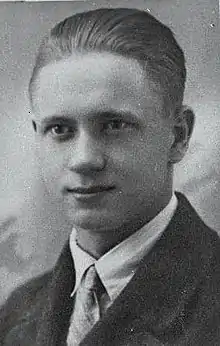Leninist Young Communist League of Estonia
The Leninist Young Communist League of Estonia (Estonian: Eestimaa Leninlik Kommunistlik Noorsooühing, ELKNÜ) was a political youth organization that served as the Estonian branch of Komsomol and as the official youth organ of the Estonian Communist Party (EKP). It existed from 1940 until the dissolution of the EKP in 1991.
| Leninist Young Communist League of Estonia ELKNÜ ЛКСМЭ | |
|---|---|
 Emblem | |
| Founded | 1940 |
| Preceded by | Young Communist League of Estonia |
| Dissolved | 1991 |
| Headquarters | Tallinn, Estonian Soviet Socialist Republic |
| Membership | 162,202 (1980) |
| Ideology | |
| Mother party | Communist Party of the Soviet Union |
| State party | Communist Party of Estonia |
| International affiliation | World Federation of Democratic Youth |
| National affiliation | Komsomol (until 1989) |
| Newspaper | Noorte Hääl |
History

Formed in the wake of the Soviet occupation of Estonia in 1940, the ELKNÜ acted as the successor to the clandestine Young Communist League of Estonia, which operated during the interbellum. As in other branches of the Komsomol, the ELKNÜ facilitated the provision of ideological instruction, leisure activities, volunteer work, sporting, technical training, theatre and drama clubs, and other activities to engage youth and develop politically and socially dedicated future party members.[1] In preparation for the sailing program at the 1980 Summer Olympics, the ELKNÜ assisted in the construction of olympic facilities in Tallinn. Throughout its existence, ELKNÜ youth volunteers engaged in projects across the Soviet Union including the Virgin Lands campaign and the construction of the Baikal–Amur Mainline. By 1980, the ELKNÜ had 162,202 members.[2]
Faced with declining membership in the wake of the push for independence in the late 1980s (including a mass resignation of members in 1987), the ELKNÜ elected to withdraw itself from the Soviet Komsomol and pursue a new programme congruent with an independent Estonia in November 1989. It reconstituted itself after three months as an organisation unaffiliated with the union-wide Komsomol, though membership dropped to 30,000 by 1990.[3] Nevertheless, the decision of the EKP and ELKNÜ to stand against Moscow and support the move for independence enabled Estonian communists and socialists to maintain some popularity among the population, which has played a role in the post-independence Estonian political sphere.[4]
The official newspaper of the organization, published by the Central Committee (Keskkomitee) of the ELKNÜ, was Noorte Hääl.
| Name | Term |
|---|---|
| Erich Tarkpea | 1940 – 1941 |
| Oskar Cher | 1941 – 1942 |
| Juliana Telman | 1943 – 1944 |
| Arnold Meri | 1945 – 1949 |
| Boris Tolbast | 1949 – 1955 |
| Vaino Väljas | 1955 – 1961 |
| Jaan Lüllemets | 1961 – 1964 |
| Taimo Suuresaar | 1964 – 1966 |
| Rein Pollimann | 1966 – 1969 |
| Aare Purga | 1969 – 1972 |
| Indrek Toome | 1972 – 1978 |
| Donald Visnapuu | 1978 – 1984 |
| Arno Almann | 1984 – 1988 |
References
- Miljan, Toivo (2015). Historical Dictionary of Estonia. Rowman & Littlefield. pp. 167–68. ISBN 978-0810875135.
- Raun, Toivo (February 2002). Estonia and the Estonians: Second Edition, Updated. Hoover Press. p. 209. ISBN 0817928537.
- Pilkington, Hilary (2013). Russia's Youth and its Culture: A Nation's Constructors and Constructed. Routledge. ISBN 978-1134876433.
- Backes, Uwe; Moreau, Patrick (2008). Communist and Post-communist Parties in Europe. Vandenhoeck & Ruprecht. p. 172. ISBN 978-3525369128.
- Graf, Mati (2008). Kalevipoja kojutulek: 1978. aasta poliitilisest pööripäevast 1988. aasta suveräänsusdeklaratsioonini [Kalevipoeg's Homecoming: The 1988 Declaration of Sovereignty on the Political Equinox of 1978] (in Estonian). Argo. ISBN 978-9949438532.